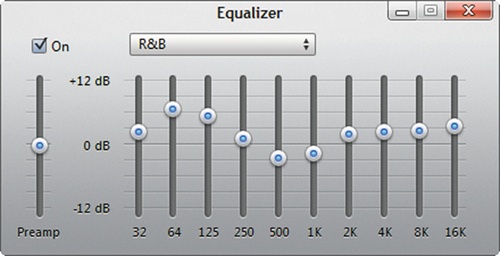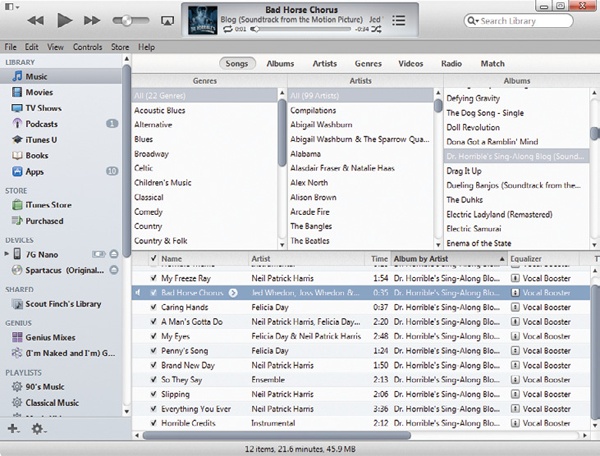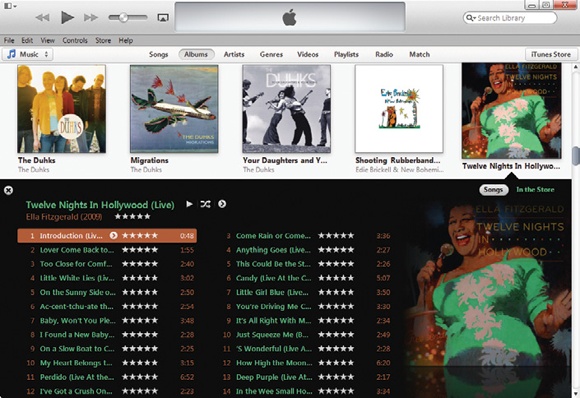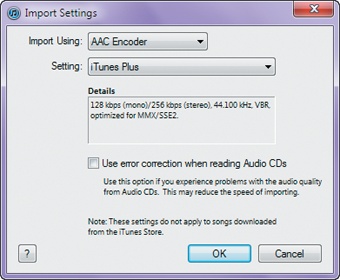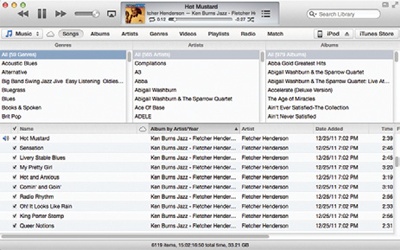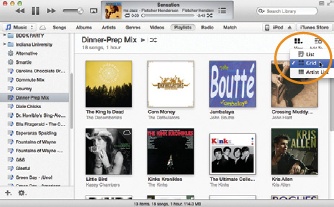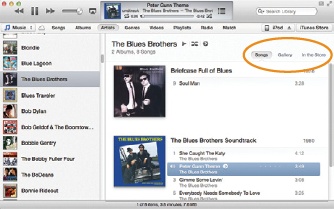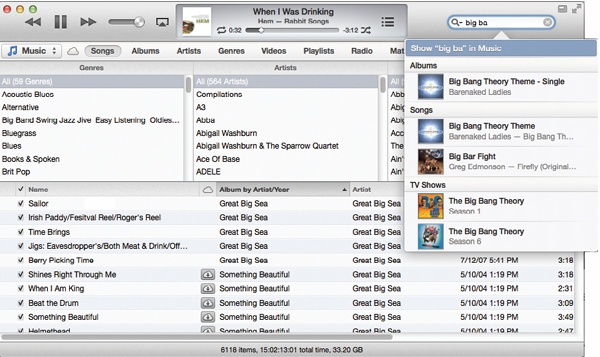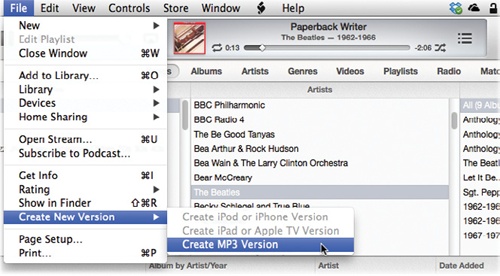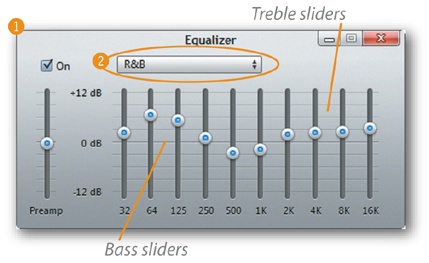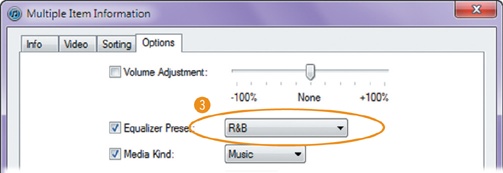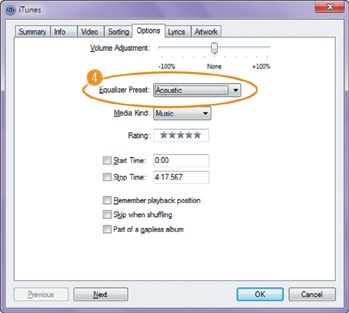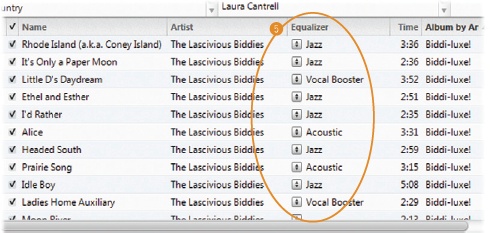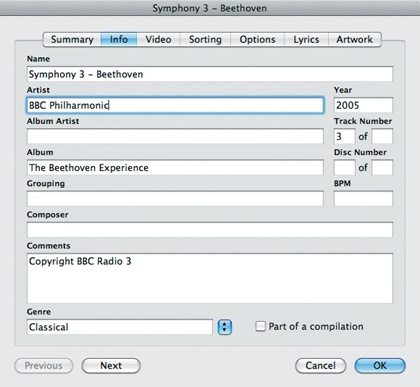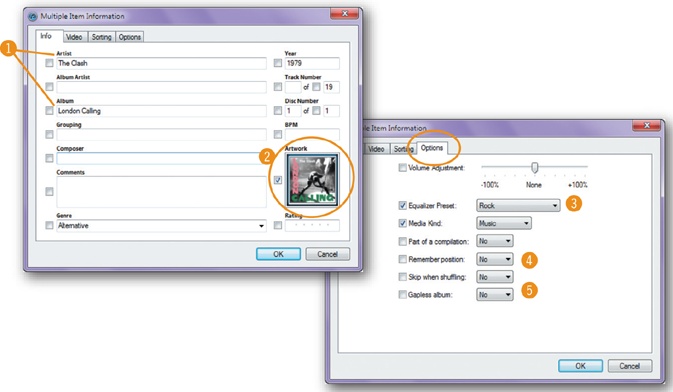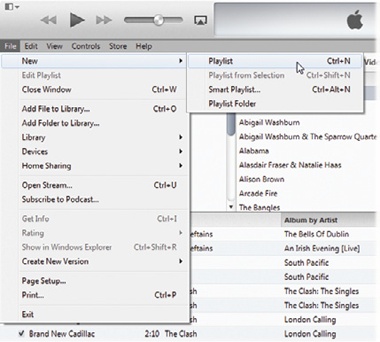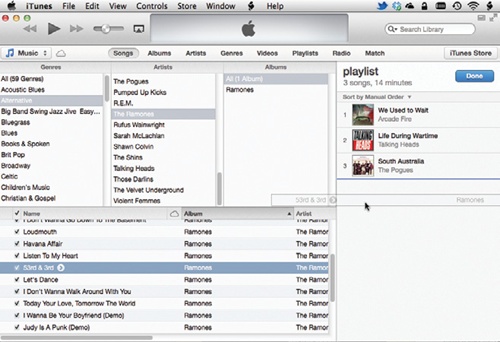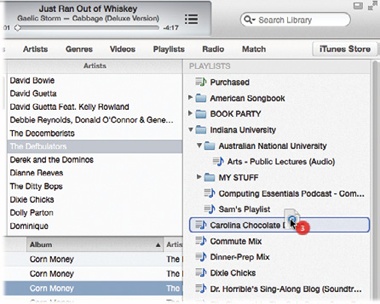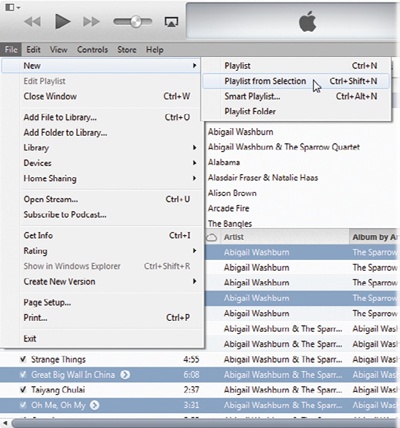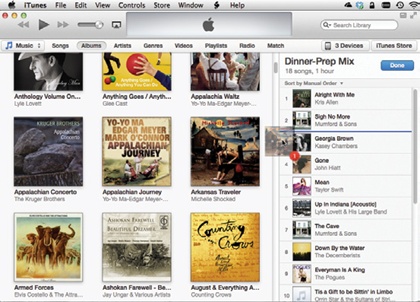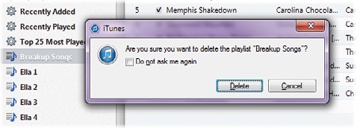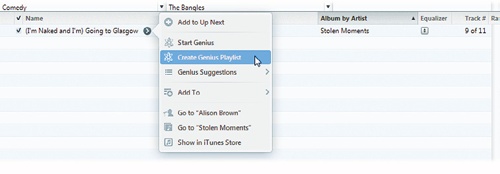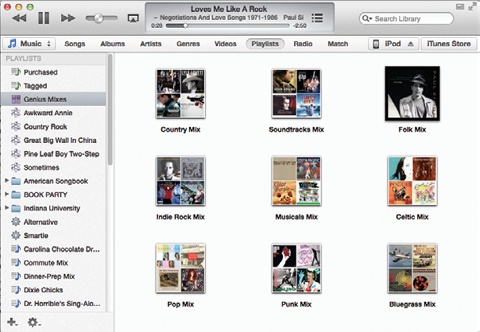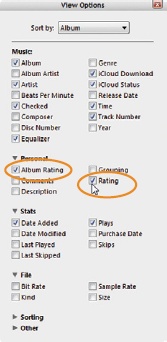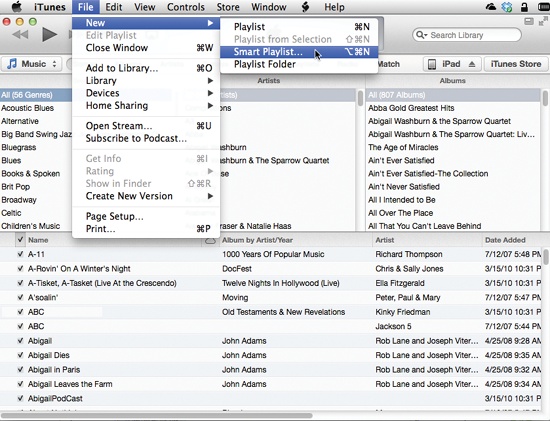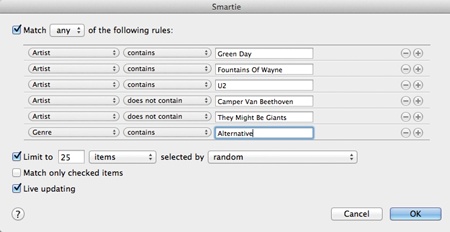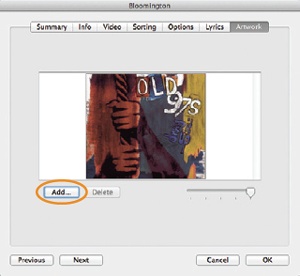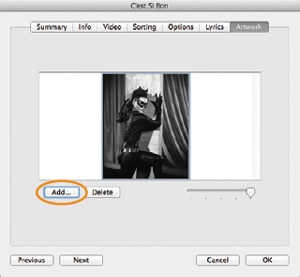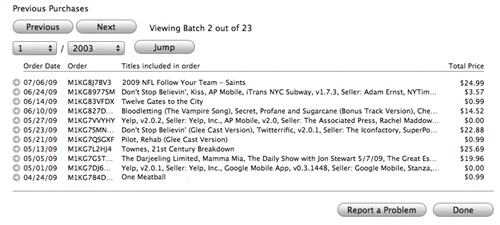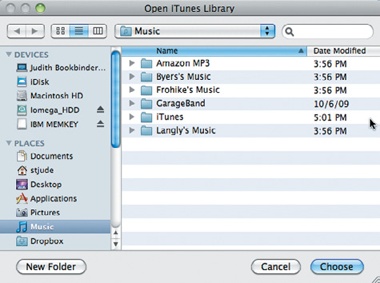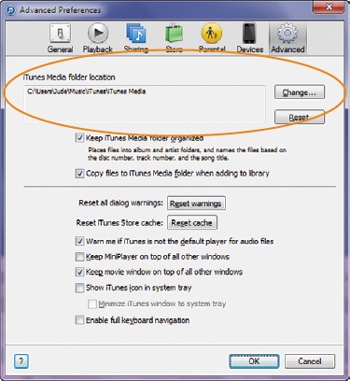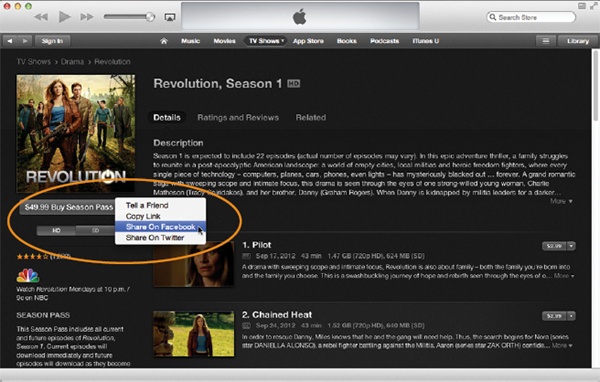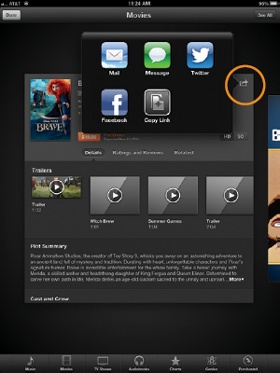Chapter 13. Master iTunes On the Desktop
You’ll learn to:
Customize iTunes’ look
Automatically create playlists
Edit song and album info
Add custom album art
Create multiple iTunes libraries
AS YOU CAN TELL from the last chapter, iTunes is an important part of your iPad experience. Even if you use the airy offerings of iCloud to back up, re-download, or match your music, iTunes converts tracks from your own CDs to iPad-ready digital files. It also lets you organize your media library locally on your computer—no iCloud connection necessary. And if you don’t use iCloud, iTunes brokers the transfer of songs, music, videos, books, personal info, and apps between your computer and your tablet.
If you’ve never had an iPod or iPhone before you got your iPad, you may not know what a powerful media jukebox iTunes is. In addition to managing your media, iTunes lets you easily organize it into playlists (customized song lists) that you can copy over to your iPad. Don’t feel like mixing your own music? Let iTunes do it for you automatically with its Genius and Smart Playlists features.
This chapter also explains how you can customize iTunes’ look, change a song’s file format, adjust each song’s equalizer settings, and keep your iTunes libraries on an external drive for safekeeping. So when it comes time to charge your iPad for a few hours, take a spin through iTunes.
Change the Look of the iTunes 11 Window
WITH ITUNES 11, APPLE radically overhauled the look of its all-purpose media manager for the first time in nearly 10 years. For newcomers to iTunes, that wasn’t a problem since they had to learn whole new program anyway. For some long-time users, it was a change long overdue, but for some it was also a jarring change that instantly lead to the question, “Hey, where’s all my stuff?
If you’re in that last group and long for the days of the Source panel that vertically listed all your libraries, connected devices, playlists, the iTunes Store, and everything else iTunes handled, fear not—Apple has not abandoned you. With just a few quick trips to the View menu, you can get back to familiar territory:
To restore the Source list, that vertical pane along the left side of the window, choose View→Show Sidebar.
To restore the multi-pane column browser in the Songs list that showed your collection sorted by genre, artist, album, composer, and grouping, choose View→Column Browser→Show Column Browser and pick your options.
To see the information bar at the bottom of the window that revealed the size of your iTunes library, choose View→Show Status Bar.
If you opt to give your iTunes 11 window a retro look, like the one shown above, you can push and pull the columns and panes by dragging their edges with your mouse. You can also right-click (Control-click) any column header to add a new category to sort by, or click the column heads and drag the columns into a whole new order.
Use the iTunes 11 MiniPlayer
LOVELY AS ITUNES IS, it takes up a heck of a lot of screen real estate. When you’re working on other things, you can shrink it down.
Full size. iTunes shows you a lot of information about your media collection; Use the iTunes 11 MiniPlayer shows off some of the looks. In Album view, shown here, just click a cover to see all the tracks you have from that recording, along with playback controls. You can expand the player to full-screen view by clicking the standard “maximize” icon in the top-right corner of the Windows window, or the full-screen icon (
 ) in the top-right corner of the Mac
version.
) in the top-right corner of the Mac
version.MiniPlayer. It’s nice to see your collection so prominently, but if you’re just listening to music while you work on a spreadsheet, you probably don’t need iTunes hogging up your screen. In that case, switch to the mini-player by pressing Ctrl+M (Shift-⌘-M) or by choosing View→Switch to MiniPlayer. The mini-player displays the name of the current track—until you pass your mouse over it, when it switches to playback controls.
Tired of losing your iTunes mini-player among an array of windows on-screen? You can make it always visible, so that it sits on top of other open windows, documents, and assorted screen detritus. Open iTunes Preferences (Ctrl+comma [⌘-comma]), click the Advanced tab, and then turn on the checkbox next to “Keep Mini Player on top of all other windows.” Now you won’t have to click frantically around the screen trying to find iTunes if you get caught listening to your bubblegum-pop playlist at work.
Change Import Settings for Better Audio Quality
IF YOU’RE HAPPY WITH the way the music sounds on your iPad, on your Apple TV, or through a pair of external speakers, feel free to safely ignore this page. But If you find the audio quality lacking, you can change the way iTunes encodes, or converts, songs when it imports them from a CD.
iPads can play several digital audio formats: AAC, MP3, WAV, AIFF, and one called Apple Lossless. In iTunes’ Import Settings box (Edit [iTunes]→Preferences→General, and then click Import Settings), you get two main options. They are:
Audio format (use the drop-down menu beside “Import Using”). Some formats tightly compress audio to save space. The trade-off: lost sound quality. Highly compressed formats include AAC (iTunes’ default setting) and MP3. Formats that use little or no compression include WAV and AIFF; they sound better, but they take up more space. Apple Lossless splits the difference: better sound quality than AAC and MP3, but not as hefty as WAV or AIFF.
Bit rate (beside “Setting”). The higher the number of bits listed, the greater the amount of data the file contains, and the better the sound quality. The disadvantage? Large file sizes.
To see a song’s format and other technical info, click its title in iTunes, press Ctrl+I (⌘-I), and then click the Summary tab in the Get Info box. (See your name and Apple ID listed on iTunes Store tracks? Apple does keep a record of these things.)
More Ways to Browse Your Collection
INSTEAD OF JUST PRESENTING you with boring lists, iTunes gives you multiple ways to browse your media
collection, some more visual than others. Just click the appropriate
button at the top of the iTunes window. In all the views, an unadorned
cloud (![]() ) or a
) or a ![]() icon next to a title means you bought the item on
another device and can download it here from iCloud.
icon next to a title means you bought the item on
another device and can download it here from iCloud.
List view. The all-text display (shown right, top) is favored by people who use screen-reader software or find comfort in the layout of Excel spreadsheets. Clicking the Songs button automatically puts you in List view, but you can make List an option for other media by pressing Ctrl+comma in Windows or⌘-comma on a Mac. That opens the Preferences box. Click the General tab and then turn on the checkbox next to “Show list views for all media.”
Playlist view options. After you click the Playlists button, you may want to see your custom compilations displayed as a grid of album covers or sorted by artist. Click the View icon in the Playlist window (circled, middle right) and choose a new look for your list.
Artist view. Click Artists in the iTunes window to see all the bands and singers in your collection listed alphabetically along the left (shown above, bottom). Click a band’s name, and then click the Songs button in the middle of the window (circled) to see all the tracks you own by that band. Click Gallery to see online photos of the band, and click the “In the Store” button to see other albums by that artist.
Album view. This option displays your music collection as a striking collection of interactive album covers, as shown back on Use the iTunes 11 MiniPlayer.
Search iTunes
AS YOUR ITUNES MEDIA library grows, you may have trouble remembering just what songs, movies, and so on you have, or what album a song came from. In times like these, take to the trusty search box in the right-hand corner of the iTunes window.
As with search boxes on Web browsers, operating systems, and every place else they tend to appear, you just have to start typing in a keyword (the artist’s name, a song title, and so on). With each letter you type, iTunes shortens the list, showing you only titles that match what you type.
For example, typing train brings up a list of everything in your collection that has the word “train” somewhere in the song’s information—maybe in the song’s title (“Mystery Train”), the band name (Wire Train), or the album name (Train A Comin’). The search function in iTunes 11 doesn’t limit itself to just one type of media, either. As shown below, you get results from across your media empire. Click a result in the list to jump to that item.
Another way to search for specific items is to use List view and the column browser mentioned on the previous page. (If you can’t see the column browser, press Ctrl+B [⌘-B].)
Depending on how you configured the browser in View→Column Browser, it reveals your music collection grouped by genre, artist, album, composer, or grouping—all in a nice vertical list. Hit the same keys again (Ctrl+B [⌘-B]) to close the browser.
Change a Song’s File Format
SOMETIMES YOU’VE GOT a song in iTunes whose format you want to change—you might need to convert a big AIFF file before loading it onto your iPad, for example. First, head over to Edit→Preferences (iTunes→Preferences), click the General tab, and then click the Import Settings button. From the Import Using pop-up menu, pick the format you want to convert to and then click OK.
Now, in your iTunes library, select the song you want to convert and choose File→Create New Version→Create MP3 Version (or whatever format you chose).
If you have a whole folder or disk full of potential converts, hold down the Shift (Option) key as you choose File→Create New Version→Convert to MP3 (or your chosen encoding format). A window pops up so you can navigate to the folder or disk holding the files you want to convert. iTunes won’t convert protected media—Audible.com tracks and older tracks from the iTunes Store that still have copy-protection built in. If you bought a song after April 2009, though, odds are you’re delightfully free of such restrictions, since that’s when Apple stopped copy-protecting music.
iTunes deposits your freshly converted tracks in your library, alongside the songs in their original format.
Tip
Although you intentionally created a duplicate of a song here, you may have unintended dupes as a result of Home Sharing, ripping the same album twice, or other accidental copying. To find these duplicates—and recover a little hard drive space—choose View→Show Duplicate Items. iTunes dutifully rounds up all the dupes in one window for you to inspect and possibly delete. Just make sure they are true duplicates, not, say, a studio and a live version of the same song. (To find exact duplicates, hold down the Shift [Option] key and choose View→Show Exact Duplicate Items.) After you’ve done your weeding, click the Display All button to return to your full music collection.
Improve Your Tunes with the Graphic Equalizer
TO IMPROVE THE WAY your songs sound, you can use iTunes’ graphic equalizer (EQ) to adjust various frequencies when you play certain types of music. You might want to boost the bass tones in dance tracks to emphasize the booming rhythm, for example.
To get the equalizer front and center, choose View (Window)→Equalizer. Then follow these steps:
Drag the sliders (bass on the left, treble on the right) to accommodate your listening tastes (or the strengths and weaknesses of your speakers or headphones). You can drag the Preamp slider up or down to compensate for songs that sound too loud or too soft.
Use the pop-up menu to choose one of the canned presets for different types of music (Classical, Dance, Jazz, and so on). To create your own presets, click the pop-up menu and select Make Preset.
You can apply equalizer settings to an entire album or to individual songs.
To apply settings to a whole album, select the album’s name (either in Grid view or in the iTunes browser pane). Then press Ctrl+I (⌘-I) and click Yes if iTunes asks whether you’re sure you want to edit multiple items. In the box that pops up, click the Options tab and choose your preferred setting from the Equalizer Preset pull-down menu.
Note
Equalization is the art of adjusting the frequency response of an audio signal. An equalizer emphasizes, or boosts, some of the signal’s frequencies while lowering others. In the range of audible sound, bass frequency is the low rumbly noise; treble is at the opposite end of the sound spectrum, with high, even shrill, notes; and midrange is, of course, in the middle, and it’s the most audible to human ears.
You can apply equalizer presets to individual songs as well. Instead of selecting the album name in the iTunes window, click the song name, and then press Ctrl+I (⌘+I). Click the Options tab and choose a setting from the Equalizer Preset menu.
Finally, you can change the EQ settings right from the Songs list view by adding an Equalizer column. Choose View→View Options and turn on the Equalizer checkbox. A new column appears in your track list, where you can select EQ settings.
Tip
The iPad itself has more than 20 equalizer presets you can use on the go. To set your iPad’s equalizer, choose Settings→Music→EQ. Flick down the list of presets until you find one that matches your music style, and then tap it. Your iPad now lists the preset’s name next to EQ on the Settings menu.
Edit Song Information
TIRED OF SONG-NAME TYPOS from an online database marring your lovely library? You can change track titles in iTunes a couple of ways.
When you see a song title in any of the views (Songs, Albums, Artists, Genres, or Playlists), click the text you want to change, wait a moment, and then click again. The title now appears highlighted, and you can edit the text—just as you do when you change a file name on a desktop computer.
Another way to change a song’s title, artist name, or other information is to click the song title in the iTunes window and press Ctrl+I (⌘-I) to summon the Get Info box. (Choose File→Get Info if you forget the keyboard shortcut.) Click the Info tab and then type in the new track information.
If you still have the CD, insert it into the computer, select it from the Library pop-up menu, and then click Options→Get CD Track Names to see if the Internet has any updated listings. (If the track is something deeply obscure or homemade, the Gracenote database that iTunes uses may not know the name, either.)
Tip
Once you have a song’s Get Info box on-screen, use the Previous and Next buttons to navigate to other tracks grouped with it in the iTunes song list. That way, you can rapidly edit all the track information in the same playlist, on the same album, and so on, without closing and opening boxes the whole time.
Edit Album Information and Song Gaps
YOU DON’T HAVE TO adjust your track information on a song-by-song basis. You can edit an entire album’s worth of tracks simultaneously by clicking the album name in the iTunes column browser (or by clicking its cover in Album view) and pressing Ctrl+I (⌘-I) to bring up the Get Info box.
Ever careful, iTunes flashes an alert box asking if you really want to change the info for a bunch of things at once. Click Yes.
You can make all sorts of changes to an album in the four-tabbed box that pops up. Here are a few examples:
Fix a typo or mistake in the Album or Artist name boxes.
Manually add an album cover or photo of your choice to the whole album by dragging it into the Artwork box. (You can add an album rating below that).
Click the Options tab and change the equalizer preset for all the songs. Right below that, use the Media Kind menu to change a mislabeled Music file to, say, Audiobook, for proper sorting.
Have iTunes skip the album when you shuffle music—great for keeping winter holiday music out of your summer barbecue album rotation.
Tell iTunes to play back the album without those two-second gaps between tracks by choosing “Gapless album” (perfect for opera and Abbey Road !).
Make a New Playlist in iTunes 11
TO CREATE A PLAYLIST, press Ctrl+N (⌘-N) in iTunes. You can also
choose File→New→Playlist or click the ![]() button in the bottom-left corner of the iTunes
window.
button in the bottom-left corner of the iTunes
window.
All freshly minted playlists start out coldly named “playlist.” Fortunately, iTunes highlights this generic moniker so it’s ready for editing—just type in a better name: “Cardio Workout,” “Hits of the Highland Lute,” or whatever you want to call it. As you add playlists, iTunes alphabetizes them in the Playlists area of the Source list.
Once you create and name a spanking-new playlist, you’re ready to add songs or videos. You can do so several ways, so choose the one you like best.
Playlist-Making Method #1
When you choose the New Playlist option, iTunes 11 pops open a panel on the right side of its window. This is your blank canvas to create a sonic masterpiece. At the top of the column, type the name you want to use for your new playlist if you haven’t done so already. Make sure the pop-up menu on the left side of the iTunes window is set to Music. Now, click around the tabs at the top of the iTunes library window (Songs, Albums, Artists, and so on) and drag the songs or albums into the playlist column. Drag songs one at a time, or grab a bunch by selecting tracks one after the other; just Ctrl-click (⌘-click) each title. Click the Done button when you’re finished.)
Playlist-Making Method #2
Want a way to keep adding new songs to an existing playlist? Highlight the songs you want to add in the main iTunes window (Ctrl-click [⌘-click] each one) and then drag them over to the right side of the iTunes window—which conveniently pops open the playlist panel for you to drop the songs onto the playlist of your choice.
If your iPad is connected to iTunes, click its icon in the iTunes window and click On This iPad on the next screen. Click the Add To button on the right side of the window to reveal a pane showing the iPad’s contents. Click the Playlists button and drag your mixes from the left side of the window onto the iPad’s pane.
Playlist-Making Method #3
You can also choose songs in your library and then create a playlist out of the highlighted songs. Select tracks by Ctrl-clicking (⌘-clicking) the titles.
Choose File→New→Playlist From Selection, or press Ctrl-Shift-N (⌘-Shift-N). The songs you selected appear in a brand-new playlist. If all of them came from the same album, iTunes names the playlist after the album (but it also highlights the name so you can change it).
Don’t worry about clogging up your hard drive. When you drag a song title onto a playlist, you don’t copy the song, you just tell iTunes where to find the file. In essence, you’re creating a shortcut to the track. That means you can have the same song on several playlists, but only one copy of it resides on your computer.
That nice iTunes even gives you some playlists of its own devising, like “Top 25 Most Played” and “Purchased” (a convenient place to find all your iTunes Store goodies listed in one place).
Edit or Delete a Playlist
IF YOU CHANGE YOUR mind about a playlist’s tune order, drag the song titles up or down within the playlist window. Just make sure to sort the playlist by song order first (click the top of the first column, the one with the numbers listed in front of the song titles).
You can always drag more songs into a playlist by selecting the songs and dragging them to the right side of the iTunes window. When you do, a hidden panel opens to reveal a list of existing playlists; drop the tracks onto the playlist you want to use.
When you click the Playlists button in the main iTunes window (and select a mix from the column on the left side), you can also click the Add To button on the right side of the window to go into playlist-editing mode, as shown here. You can re-sort the songs, add new ones, delete old ones (select a title and hit the Delete key), and get that mix into playing shape. To see a selected playlist’s tracks displayed in List, Album, or Artists view, click the View button and pick one.
Another way to quickly add a song to an existing playlist right from the main iTunes window, no matter which view you happen to be using: Select the song, right-click (Control-click) it, and then, in the pop-up menu, choose “Add to Playlist.” Scroll to the playlist you want to enrich and then click the mouse button to add the track.
When you decide it’s time to remove a song or mix from your collection in iTunes, click the Playlists button to see your song sets. Click a song or playlist title, and then hit Delete or Backspace. When iTunes asks you to confirm your decision, click Yes. Remember, deleting a song or a playlist doesn’t delete the tracks from your music library—it just removes the title, or that particular playlist. (You can get rid of a song for good only by pressing Delete or Backspace from within the iTunes Music library, which you get to from the Library pop-up menu on the top-left side of the main window.)
Make a Genius Playlist in iTunes
PLAYLISTS ARE FUN to make, but occasionally you just don’t have the time or energy. If that’s the case, call in an expert—the iTunes Genius. With the Genius feature, you click any song you’re in the mood for and iTunes crafts a playlist of 25 to 100 songs that it thinks go well with the one you picked.
The first time you use it, Genius asks permission to go through your music collection and gather song information. Then it uploads that data to Apple. When your information has been analyzed (by software) and anonymously added to a giant database of everybody else’s song info (to improve the Genius’s suggestions), the Genius is ready for duty. Here’s the procedure:
Click the Songs button atop the iTunes window and then click a song title.
Click the
 icon at the end of a song’s name in the
iTunes list window and choose Create Genius Playlist; you can click
icon at the end of a song’s name in the
iTunes list window and choose Create Genius Playlist; you can click
 in the Album and Artist views as well. You
can also click
in the Album and Artist views as well. You
can also click  next to the name of the currently playing
song in the iTunes display window to get to the same menu.
next to the name of the currently playing
song in the iTunes display window to get to the same menu.iTunes presents you with your new playlist in a flash.
Use the Refresh button (
 ) at the top of the Genius window to refresh
the playlist with new songs if you want a different mix. Click the
triangle next to the number of songs to change it from the default
25 to 50, 75, or 100 songs.
) at the top of the Genius window to refresh
the playlist with new songs if you want a different mix. Click the
triangle next to the number of songs to change it from the default
25 to 50, 75, or 100 songs.
iTunes saves the new Genius playlist in the same area as all your other playlists. Just click the Playlists button at the top of the iTunes window to see it. The Genius doesn’t work if it doesn’t have enough information about a song—or if there aren’t enough similar songs for it to draw from. In that case, pick another tune. If you frequently add new music to your library and want to get it in the mix, inform the Genius at Store→Update Genius.
Make Genius Mixes in iTunes 11
YES, THE ITUNES GENIUS feature takes almost all the effort out of making a playlist—all you do is click the Genius button. But if even a one-button click seems like too much effort, iTunes makes playlist creation even easier. Welcome to Genius Mixes.
The Genius Mix feature works like this: iTunes takes it upon itself to search your entire music library and then automatically compose (depending on the size of your library) up to 12 song collections. Unlike a Genius playlist of songs calculated to go well together, a Genius Mix is more like a radio station or cable-TV music channel, with the music based on genre. Depending on what’s in your iTunes library, the Genius could present you with a hip-hop mix, a country mix, a classical mix, and so on. In addition, the Genius Mix creates up to 12 playlists at once, all saved and ready to play, unlike the Genius’s single mix that you have to save to preserve.
If you don’t already see a square purple Genius Mix icon
(![]() ) in your iTunes Source list, choose Store→Update
Genius. Once activated, the Genius quietly stirs up its sonic
concoctions from your music library.
) in your iTunes Source list, choose Store→Update
Genius. Once activated, the Genius quietly stirs up its sonic
concoctions from your music library.
To play a Genius Mix, click the Playlists button at the top of the iTunes window and click the Genius Mixes icon in the list on the left. iTunes displays the different mixes it’s created. It represents each by a quartet of album covers from tracks in the mix. Pass your mouse over the album squares to see the name of the mix, or click the squares to start playing the songs.
Like more traditional radio stations, you don’t get to see what’s actually in a particular Genius Mix—unless you know where to look. (To find out, go to Manage Your Expectations With Up Next, which explains iTunes’ Up Next feature.) If you don’t care for a song at the moment, playback controls on the Genius Mix album covers let you jump forward or backward in the mix.
Genius Mixes can be another great way to effortlessly toss on some background music at a party, and you may even hear songs you haven’t played in forever. Want to take the Genius Mix with you? Just sync it to your iPad.
You’re the Critic: Rate Your Music
ALTHOUGH THERE’S NO WAY to give a song two thumbs up in iTunes, you can assign an album—or each song in your collection—a rating of from one to five stars. Then you can use the ratings to produce playlists of nothing but the greatest hits on your hard drive.
First, a couple of notes: If you assign an album a rating, then all the songs on the album get the same number of stars. If you rate just a few tracks on an album, the album’s rating reflects the average of the rated songs—so an album with two five-star songs and a bunch of unrated tracks gets five stars. Now, to configure:
Click the Songs button at the top of the iTunes window. To add ratings, first make sure you turn on the Album Rating and/or Rating columns in iTunes’ View Options box (Ctrl+J [⌘-J]).
Highlight the song you want to rate by clicking it. iTunes displays five dots in the Rating column (in the Songs view of iTunes’ main window). When you click a dot, iTunes turns it into a star. Now either drag your mouse across the column to create one to five stars, or click one of the dots itself to apply a rating (click the third dot, for example, and iTunes gives the song three stars). You can also rate a song as it’s playing by clicking the
 A icon next to its title at the top of the
iTunes window and swiping the dots into stars.
A icon next to its title at the top of the
iTunes window and swiping the dots into stars.Once you assign ratings, use them. You can sort your song list by star rating (click the Album Rating or Rating column title), create a Smart Playlist of only your personal favorites (go to File→New→Smart Playlist and choose Album Rating or Rating from the first drop-down menu), and so on.
You can even rate songs on your iPad itself, and iTunes records
the ratings the next time you sync up. To rate a song currently playing
on your tablet, tap the tiny album cover at the top of the window to get
to the New Playing screen. Tap the screen to summon the playback
controls and tap the ![]() icon in the lower-right corner to get to the
track list. Swipe the dots across the top of the screen until they turn
into the corresponding number of stars you want to assign.
icon in the lower-right corner to get to the
track list. Swipe the dots across the top of the screen until they turn
into the corresponding number of stars you want to assign.
Smart Playlists: Another Way for iTunes to Assemble Song Sets
AS COOL AS THE Genius is, sometimes you want a little more control over what goes into your automatically generated music mixes. That’s where Smart Playlists rise to the occasion.
Once you give it some guidelines, a Smart Playlist goes sniffing through your music library and comes up with custom mixes based on those guidelines. A Smart Playlist even keeps tabs on the music that comes and goes from your library and adjusts itself based on that.
You might tell one Smart Playlist to assemble 45 minutes’ worth of songs that you’ve rated higher than four stars but rarely listen to, and another to play your most-often-played songs from the 1980s. The Smart Playlists you create are limited only by your imagination. (Flip back a page for more on ratings.)
To start a Smart Playlist, press Ctrl+Alt+N (Option-⌘-N) or choose File→New Smart Playlist. A Smart Playlist dialog box opens: It sports a gear-shaped icon (
 ) next to its name in the Playlists area (a
regular playlist has a blue music note beside it).
) next to its name in the Playlists area (a
regular playlist has a blue music note beside it).Give iTunes detailed instructions about what you want to hear. You can select a few artists you like and have iTunes leave off the ones you’re not in the mood for, pluck songs that only fall within a certain genre or year, and so on. To add multiple, cumulative criteria, click the
 button. If you decide later that you want to
narrow things down, click the - button to remove songs from
contention for the Smart Playlist.
button. If you decide later that you want to
narrow things down, click the - button to remove songs from
contention for the Smart Playlist.Turn on the “Live updating” checkbox. This tells iTunes to keep the playlist updated as your collection, ratings, and play count change. (The play count tells iTunes how many times you’ve played a track, a good indicator of how much you like a song.)
To edit an existing Smart Playlist, right-click (Control-click) the playlist’s name. Choose Edit Smart Playlist. You can also change up your playlist formula by clicking the playlist name in the Playlists area of the iTunes Source list and choosing File→Edit Smart Playlist.
A Smart Playlist is a dialogue between you and iTunes: You tell it what you want in as much detail as you want, and the program whips up a playlist according to your instructions.
You can even have a Smart Playlist pull tracks from your current
Genius playlist. Just click the ![]() button to add a preference, choose Playlist as
another criteria, and then select Genius from the list of available
playlists.
button to add a preference, choose Playlist as
another criteria, and then select Genius from the list of available
playlists.
Fetch Missing Album Art
SONGS YOU DOWNLOAD FROM the iTunes Store often include artwork—usually a picture of the album cover. iTunes displays the picture in just about every view but the text-based Songs list. But even if you rip most of your music from your own CD collection, you’re not stuck with artless tracks. You can ask iTunes to head to the Internet and find as many album covers as it can.
You need a (free) Apple account to make this work, so if you haven’t signed up yet, choose Store→Create Apple ID to get rolling. To make iTunes go fetch, choose File→Library→Get Album Artwork. Since Apple has to root around in your library to figure out which covers you need, you get an alert box warning you that the company will be getting (and then dumping) personal information from you (but it’s not laughing at your Bay City Rollers tracks).
If you have a huge library, this may take a little while. When iTunes finishes, you should have a healthy dose of album art filling up the iTunes window.
If iTunes can’t find certain album covers on its own, it displays a list of the missing artwork. You can use this helpful accounting to hunt for and place the art yourself. So, you ask, where do you handpick this artwork? In short: the Web.
Sites like Amazon are a great source of album covers. Here’s what to do:
Locate the cover you want on the Web and save a copy of it by dragging it off the web page and onto your desktop, or by right-clicking (Control-clicking) it and choosing the “Save Image” option in your web browser.
Add artwork by clicking a song title, typing Ctrl+I (⌘-I) to open the Get Info box, and then clicking the Artwork tab.
Click the Add button to call up a box that lets you choose an image from your hard drive—like the one you just snagged. If you don’t like the album’s art, you can add a JPEG photo of your own. Just select that picture when you click the Add button and use the slider to adjust its size. You can also art up a whole album with the same image at once, as explained on Edit Album Information and Song Gaps.
See Your iTunes Purchase History and Get iTunes Store Help
EVER NOTICE SONGS in a playlist or in your iTunes library, (perhaps when searching for something), that you don’t remember buying? Good thing that iTunes keeps track of what you buy and when you buy it. If you suspect that one of the kids knows your password and is sneaking in forbidden downloads or that your credit card was wrongly charged, you can contact the Store or check your account’s purchase history to see what’s been downloaded in your name.
To do the latter, in the iTunes Store window, click your account name, log in, and then click View Account. On the Account Information screen, click See All next to Purchase History. Your latest purchases appear at the top of the page, and you can scroll farther down to see a list of previous acquisitions. Everything billed to your account over the months and years is there, including gift-certificate purchases. If you see something wrong, click the “Report a Problem” link to say something.
If you have other issues with your account or want to submit a specific query or comment, the online help center awaits. From the iTunes Store’s main page, click the Support link. Your web browser presents you with the main iTunes service and support page; click the link that best describes what you want to learn or complain about. For billing or credit card issues, check out the iTunes Account and Billing Support link on that same page.
Tip
With iTunes in the Cloud and iTunes Match, backing up your library of purchased and home-ripped content isn’t much of a worry. But if you can’t—or prefer not to—use those services, make sure you back up your iTunes Media/Music folder to another hard drive or to discs regularly with Windows Backup, Mac OS X Time Machine, or another backup solution. And while you’re at it, why not back up everything on the computer?
Set Up Multiple iTunes Libraries
THERE’S HOME SHARING, AND then there’s home, sharing. Many families have just one computer. If everyone uses the same copy of iTunes, you soon hear the Wiggles bumping up against the Wu-Tang Clan if you shuffle your music tracks or when you autosync multiple iPads. Wouldn’t it be great if everyone had a personal iTunes library to have and to hold, to sync and to shuffle—separately? Absolutely.
To use multiple iTunes libraries, follow these steps:
Quit iTunes.
Hold down the Shift (Option) key on your Windows PC or Mac keyboard and launch iTunes. In the box that pops up, click Create Library. Give it a name, like “Tiffany’s Music” or “Songs My Wife Hates.”
iTunes opens up, but with an empty library. If you have a bunch of music or videos in your main library that you want to copy over to this one, choose File→Add to Library.
Navigate to the files you want and add them. If the songs are in your original library, they’re probably in Music→iTunes→iTunes Media→Music (Home→Music→iTunes→iTunes Media→Music), in folders sorted by artist name; videos are in TV Shows or Movies. Choose the files you want to add.
To switch among libraries, hold down the Shift (Option) key when you start iTunes, and you’ll get a box that lets you pick the library you want. (If you don’t choose a library, iTunes opens the last one used.) Content you copy goes into the library currently open. And now that you have those files in your new library, you can switch back to the old one and get rid of the tunes there.
Move Your iTunes Media Folder to an External Drive
MEDIA LIBRARIES GROW LARGE, and hard drives can seem to shrink as you add thousands of songs and hundreds of videos to iTunes. You may, in fact, think about using a big external drive for iTunes storage. That’s just dandy, but you need to make sure iTunes knows what you’re up to.
If you rudely drag your iTunes Media (or Music) folder to a different place without telling iTunes, it thinks the songs and videos in your collection are gone. The next time you start the program, you’ll find a newly created, empty Media/Music folder. (While iTunes remains empty but calm,you may be having heart palpitations as you picture your media collection vanishing in a puff of bytes.)
Before you move the Media/Music folder to a new drive, make sure iTunes has been putting all your songs and videos in the iTunes Media/Music folder by opening the Preferences box (Ctrl+comma [⌘-comma]) and confirming the folder location. Then:
Click the Advanced tab and then turn on the checkbox next to “Keep iTunes Media folder organized.”
Click the Change button next to the phrase “iTunes Media folder location,” and then navigate to your external hard drive.
Click the New Folder button in the dialog box, type in a name for the new iTunes library, and then click Create.
Back in the Change Media Folder Location box, click the Open button.
Click OK to close the iTunes Preferences box.
Choose File→Library→Organize Library and then check “Consolidate files.”
Ignore the ominous warning (“This cannot be undone”) and let iTunes heave a complete copy of your iTunes folder to the external drive. Once you confirm that everything is in the new library, trash your old iTunes Media folder and empty the Recycle Bin or Trash to get all those gigs of hard drive space back.
iTunes and Social Media
IF YOU SPEND ANY amount of time online these days, there’s no escaping Facebook and Twitter as sources of breaking news, information, and sharing. Social media is here to stay.
Even though Ping, Apple’s attempt at a music-themed social network, flopped hard after two years, shutting down in September 2012, there are still ways to use the power of Facebook and Twitter to share your taste in music, movies, books, apps, and podcasts—right from the iTunes Store.
On just about any product page in the store, an arrow beside the Buy button offers a pop-up menu (circled below) with four ways to share your idea of a cool purchase: Tell a Friend (by email), Copy Link (for pasting into a blog or other online page), Share on Facebook, and Share on Twitter. Once you make your selection and share, your recipients and readers see the news and can click the link you so thoughtfully provided to that item in the Store.
Yes, using these links gives Apple free publicity by having you flog its wares. But sharing links from the Store can also help promote a small indie band, a new podcast, or a TV show you think your friends should be watching, too—so you can all talk about it online.
You can also tout your taste in the iPad versions of Apple’s
iStores. In the top corner of any product page, tap the
![]() icon (circled above) to open a menu of sharing
options: Mail, Messages, Twitter, Facebook, or the good old Copy
option.
icon (circled above) to open a menu of sharing
options: Mail, Messages, Twitter, Facebook, or the good old Copy
option.
To use the Facebook and Twitter options, you need to have your accounts linked to the iPad’s Facebook (Use Facebook on the iPad) or Twitter (Use Twitter) apps in iOS 6. And if you haven’t set up Mail or Messages yet, take a stroll through Chapter 6.
Get iTunes News on Twitter
Apple maintains a number of official Twitter feeds. To keep up with the latest news from iTunes World, follow these self-explanatory Apple accounts:
@iTunesMusic
@AppStore
@iTunesTV
@iTunesMovies
@iTunesU
@iBookstore
@iTunesPodcasts
To follow any account, open the Twitter app, tap the
![]() icon, and then type the name of the feed you
want to see. On the search results screen, tap the People tab at the
top of the window, find the account (say, @iTunesU) in the list, and
then tap the Follow button to add the account to your own Twitter
feed.
icon, and then type the name of the feed you
want to see. On the search results screen, tap the People tab at the
top of the window, find the account (say, @iTunesU) in the list, and
then tap the Follow button to add the account to your own Twitter
feed.

